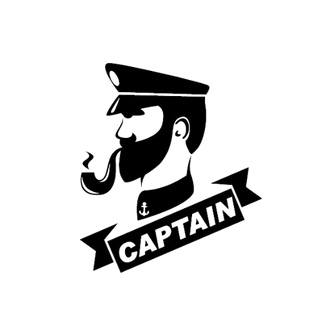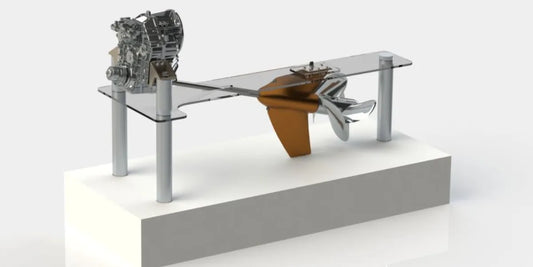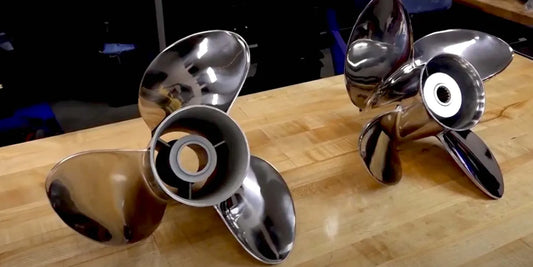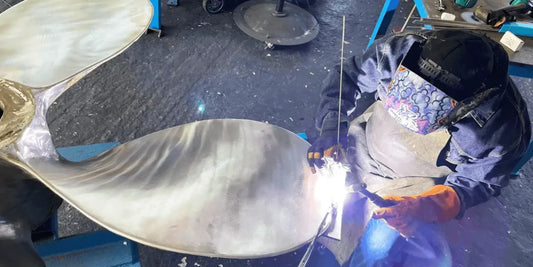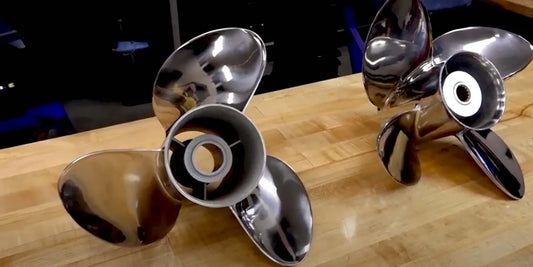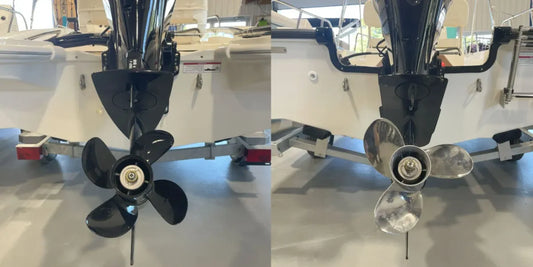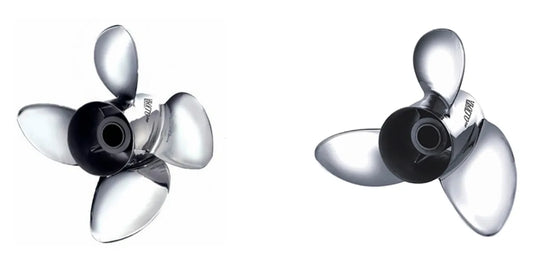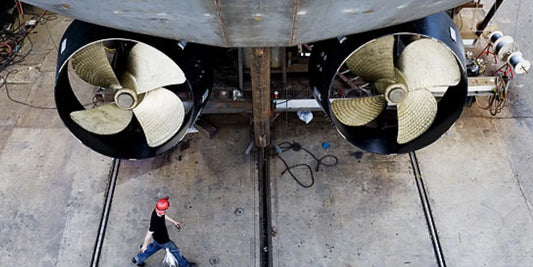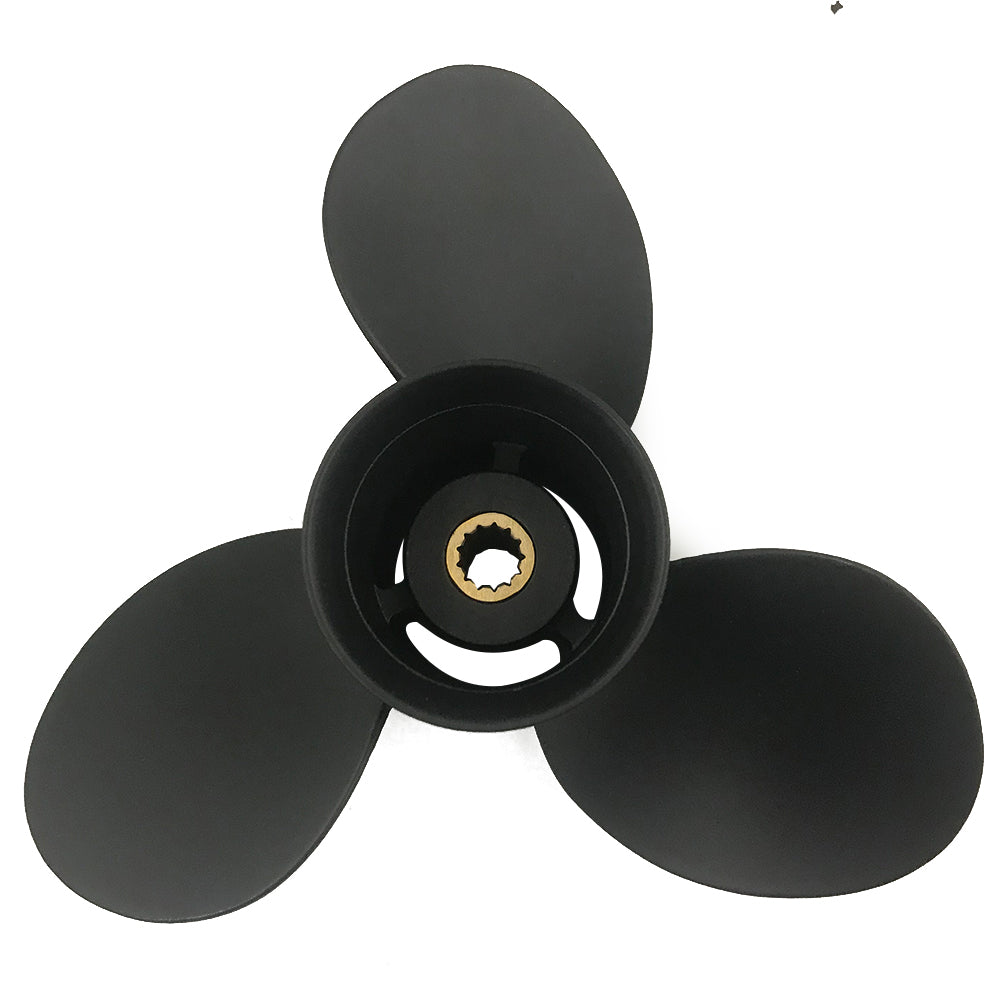Boat performance gets the best treatment when you decide whether to go with a 3-blade propeller or a 4-blade propeller. Among the key factors affected are speed, fuel efficiency, handling, and, finally, the overall nautical experience. So, how to best decide for your needs? This article goes over the distinctions and considerations in view of which you will be able to make appropriate decisions. For smoother cruising, increased stability, or just sheer speed, a complete mark-up for all purposes will lead you in the right direction for ultimate boating experiences.
Understanding Propeller Basics

What is a Propeller?
A propeller, considered a mechanical system, is forced to rotate to push or pull a boat or plane. It consists of blades arrayed around the central hub, which are roughly shaped to move through the medium of water or air to create thrust. When the propeller rotates, the blade acts with a specific shape and pitch, accelerating the medium and resulting in a forward force on the propeller according to Newton's Third Law of Motion.
Contemporary boat propellers are made of materials such as stainless steel or aluminum to guarantee durability and efficiency in various aquatic environments. Critical criteria for choosing a propeller include diameter, pitch, and number of blades, as these affect speed, fuel economy, and handling. If you understand these, then you can better optimize your propeller choice according to your particular boating needs, which in turn ensures an enhanced experience on the water.
How Propellers Work
The propellers generate force by converting the engine's rotational power into thrust in the water, moving the boat forward or backward. The interaction between the blades of the propeller and the surrounding water creates the driving force. As the propeller rotates, its angled blades generate a pressure difference between the opposing sides of the blade, with lower pressure on the side facing the propeller and higher on the opposite side. The pressure difference creates thrust by pushing water in one direction and consequently pushing the boat in the opposite direction, as per Newton's Third Law of Motion.
Propeller efficiency depends on an array of factors: blade design, material, and rotation speed. Consider that a properly designed blade would minimize cavitation, a process by which air bubbles are created and collapsed around a propeller, reducing its effectiveness, and at times causing damage. New technologies in propeller design, including hydrodynamic blade shapes and modern materials, offer much better performance in terms of smooth rotation, vibration reduction, and less fuel consumption.
Importance of Propeller Design
The design of the propeller is an essential factor in deciding the overall performance, efficiency, and reliability of a vessel. If a propeller is optimally designed, it can transfer energy efficiently from the engine to the water. Therefore, less fuel would be consumed, lowering the cost of operational fines, while at the same time, it would produce maximum thrust. Advanced structural features, such as skewed blades and optimized pitch, are provided in modern propellers to minimize noise and vibration. The ability to reduce noise and vibrations will either prolong the life of the propulsion system or enhance passenger comfort.
With the enhancement of Computational Fluid Dynamics technology, it is possible to carry out further simulations about the water flow around the propeller blades, through which engineers could create hydrodynamic shapes to reduce drag and cavitation. Such design refinements together enhance efficiency and support environmental consciousness by eliminating wells or operations that contribute to greenhouse gas emissions. Focusing on innovative materials, such as lightweight alloys and composite materials, along with precision engineering, can lead to significant changes in propeller designs used for maritime operations, thereby ensuring better performance and long-term cost savings.
Comparing 3 Blade and 4 Blade Propellers

Performance Differences Between 3 Blade and 4 Blade
For speed, thrust, efficiency, or working conditions, their performance varies with several critical factors. In most cases, 3-blade propellers are designed to operate at high speeds with greater fuel efficiency, owing to the presence of less drag and being lighter. Applications emphasizing so-called speed will opt for these, such as a recreational boat or a vessel needing to move fast across the water. Conversely, the 4-blade type produces more thrust, with greater holding power and less vibration, which can reduce the load and improve maneuverability and stability in rough waters.
Regarding functionality, the additional blade in a 4-blade propeller increases the surface area, enhancing grip on the water for smoother operations, particularly at slower speeds. However, with this design, drag is increased slightly, thereby slightly reducing top speed compared to a 3-blade design. Furthermore, fuel efficiency seems to get somewhat lower because of the resistance offered.
Recent engineering and materialistic technological advances have somewhat leveled the performance field between the two propeller types. Modern-day 4-blade designs, for example, employ lighter materials and optimize blade geometry to reduce drag while imparting thrust benefits. The 3-blade designs, meanwhile, maintain and continue to refine their position with respect to speed and efficiency through active engineering.
Choosing between 3-blade and 4-blade propellers should be determined according to specific operational objectives, vessel type, and water conditions. A 4-blade might be a better choice for a vessel requiring all-around performance at varying speeds. A 3-blade option, on the other hand, would work for light-weight boats that seek to maximize speed and fuel economy.
Fuel Efficiency: 3 Blade vs 4 Blade
One of the most influential factors on fuel economy, the choice between a 3-blade propeller and a 4-blade propeller, depends significantly upon the vessel design and the needs of operation. In most cases, a 3-blade offering tends to go with high efficiency at max speed simply by virtue of less surface area causing drag. Hence, one finds them in speed-oriented vessels that tend to save fuel during a straight-line cruise or race.
In contrast, the 4-blade propeller provides greater stabilization and water grip, potentially enhancing capabilities at half speed and during maneuvers. They are usually preferable for operating in heavy load or rough water conditions, where the operator needs to maintain a steady fuel consumption level amid variable circumstances. Cavitation is also quite minimal in 4-blade types, resulting in smoother operational conditions that might further enhance fuel efficiency in the long run with particular engine configurations.
In both cases, blade technology and material advances further help optimize for fuel efficiency, emphasizing that the choice should consider the particular engine type and its hull design and usage. Checking the propellers from time to time and repairing them when needed will also greatly help maintain their fuel efficiency in the future.
Handling and Stability Relative to Blade Count
The number of blades directly influences the way a propeller drives, handles, and stabilizes a vessel. In general, fewer blades — meaning two or three blades — generate a lower drag and consequently, higher speed and efficiency in special conditions. However, at low speeds or with heavier loads, they sacrifice smoothness and stability. Propellers with four or more blades provide more stable thrust and better grip on the water, making them suitable for heavier boats or situations that require delicate maneuvering.
Modern technologies in hydrodynamic design and computational modeling have provided modern propellers with the capabilities to work out the balance among these trade-offs. Multiple-blade configurations will find maximum application in reducing vibration, which translates to increased passenger comfort, and, conversely, in reducing wear on the propulsion system. Their good low-speed stability also favors towing work or service through rough waters. The considerations for choosing the optimal number of blades depend on the conditions in which the vessel will operate, weight distribution, and performance emissions, ensuring good efficiency and reliable handling.
Factors Influencing Propeller Selection

Boat Type and Usage
The ideal propeller setup is determined by the type of boat and its intended use. Recreational boaters who focus on speed and water sports often install higher-pitch propellers to maximize their top-end performance for fast acceleration and high-speed, efficient cruising. On the other hand, fishermen or utility boats that prioritize low-speed control and carrying heavy weights use low-pitch propellers for thrust and tighter-area maneuvering.
In the first place, since pontoon boats have a large surface area and heavier construction, their propellers must provide thrust to overcome these factors, often being designed for maximum torque at low speeds. In the case of sailboats, folding or feathering propellers are used to reduce drag while proceeding under wind power. Among other conditions, the choice is really between saltwater and freshwater because stainless steel provides corrosion resistance for more hostile marine conditions. Owners are confident in the good performance and fuel efficiency of their propellers through design and application matching; this reduces strain on the engine, leading to improved reliability.
Diameter and Pitch Considerations
Correct pick diam and pitch will affect a boat's performance-i.e., due to speed, efficiency, and load on engines. The diameter refers to the total length of the propeller, i.e., the circle described by the rotating tip of the blades. Larger diameter propellers tend to be best suited for slow-moving, heavier craft because more water is pushed through. In contrast, smaller diameters are best suited for light, fast crafts that favor speed.
Pitch, on the other hand, is defined as the theoretical distance a boat can travel in one revolution of the propeller. Low-pitch propellers generally generate more thrust, making them ideal for heavy loads or towing. High-pitch propellers, on the other hand, are efficient and used for speed in lighter applications. It must be balanced with engine power output; otherwise, it will lead to underperformance, increased fuel consumption, and engine strain. For example, an overpitched propeller will limit RPMs (revolutions per minute) and cause poor acceleration. In contrast, an underpitched propeller will cause the engine to over-rev, putting it at risk for long-term damage.
Choosing diameter and pitch in the right combination must take into account all factors, such as boat size, engine horsepower, and intended use. Industry guidelines and testing ensure that the best possible set-up is provided for efficiency and durability. Advancements in propeller design allow for variable pitch, enabling optimization at any time; thus, operations can achieve higher efficiency and stability.
Ventilation and Propeller Efficiency
Ventilation takes place when air or exhaust gases are sucked up to the propeller blades, interrupting water flow and hence reducing thrust efficiency. It could be induced by several causes, such as excessive engine trim, too sharp turns, or the wrong positioning of the propeller relative to the waterline. When ventilation occurs, the engine over-revs, causing a loss of speed and putting undue strain on the engine itself.
Hence, to increase propeller efficiency while reducing ventilation risks, manufacturers usually incorporate features such as cupped blades, which offer better grip on water during propeller operation. Besides, such issues can be further mitigated by correctly adjusting the engine's height and using anti-ventilation plates, ensuring the propeller remains stable and operational under very adverse conditions. Data also show that maintaining an optimal balance within the hull design, engine arrangement, and propeller choice increases propulsion efficiency and improves fuel economy. From materials to design, modern propellers help resist ventilation effects, thereby producing smooth and evenly distributed performance across water conditions.
Advantages of 4 Blade Propellers

Greater Thrust and Acceleration
The 4-blade propellers are engineered to render forcible thrust under higher torque and accelerated human scenarios. They provide a larger surface area compared to their 3-bladed counterparts, which in turn displaces more water and has a better hold in the water. This feature is usually prized by vessels working through rough waters, towing, or carrying heavy freight, wherein absolute power and responsiveness must be equally ensured.
Hydrodynamics and materials technology have recently evolved to promote 4-blade propeller efficiency. By adding precisely engineered blade geometry and using high-strength alloys, cavitation has been better optimized to allow for smoother propulsions in these promising modern designs. According to recent studies, boats fitted with 4-blade propellers tend to improve acceleration and fuel consumption indubitably and hence are preferred for vessels requiring high performance and reliability.
Raw Power in Rough Waters
This propeller is famous for being so well-handled in trying marine conditions. The extra blade increases thrust while keeping it variable-the more consistent the thrust is, the better the vessel will be able to maintain stability during turbulent conditions. When there is vibrational excitement and movement, being stable means that vibrations can be reduced in rough waters, leading to smoother handling. This is used for recreational and commercial vessels. Improvements in the hydrodynamic design and newer materials have drastically reduced drag and thus improved maneuverability. According to studies, boats using newer 4-blade propellers can steer better and slip less, giving a better feel and more confidence to boaters in uncertain water conditions. Such corporate advancements link the 4-blade propellers, which everyone has come to consider the essential choice for those who want to align rough-seas performance with efficient reliability.
Noise and Vibration Reduction
The latest modern four-blade propellers have been technically developed to minimize noise and vibration for a smooth, quiet ride. The extra blade reduces the pressure difference that could exist between blades and distributes the load more evenly, thereby significantly lessening cavitation that tends to produce noise. Furthermore, accurate computational modeling, coupled with the best materials, ensures harmonious operation between the propellers and the engine systems, thereby reducing unwanted vibrations even further. Such better performance improves passenger comfort and equally reduces mechanical wear, thus increasing the lifespan of the propulsion system. These technological innovations are surely well worth the investment, translating to a much more pleasant and dependable performance on water for both passionate marine customers and professionals alike.
Final Considerations: 3 Blade vs 4 Blade

Assessing Your Specific Needs
Considerations in choosing the number of blades should reflect your boat's needs and your preferences. For instance, if I were to consider speed or fuel efficiency, I would typically go for a 3-blade prop. The 3-blade propeller experiences less drag, allowing for higher top-end speeds, which is perfect for a water ski enthusiast who likes to get there quickly or is just interested in spending time in the sun fast. Also, this type of propeller is generally less expensive and delivers fine all-around performance, making it best suited for casual or general-use boating.
Given that stability, smooth maneuvering, and control in difficult circumstances are my priorities, I might find that selecting a 4-blade prop is justified. More blades mean more grip-interference with water, which helps in heavy seas or towing heavier loads, such as wakeboarders or tubers. More to the point, 4-blade props often achieve quicker acceleration and reduction in vibration, leading to a quieter and more comfortable ride. Stability on water becomes more critical when considering passenger comfort or a peaceful fishing atmosphere.
Overall, I would need to factor in these parameters, weighed alongside my engine power and typical conditions I usually deal with while on water. Knowing every boat will perform differently, a professional may even assist with a trial run of both types to finalize the best fit for the boat and my boating style.
Making the Right Choice for the Best Boating Experience
After much study and reflection, I have concluded that the proper choice of propeller will depend on my precise needs and priorities in boating. From what I learned, if I want speed and more performance, then I would choose a three-blade propeller. It excels in top-end speed and acceleration, making it an excellent option for skiing, wakeboarding, or simply cruising at higher speeds. It is also more fuel-efficient when traveling at high speed, which could contribute to lower operating costs over time.
Meanwhile, when discussing stability issues, control, and low-speed operations, the four-blade propeller offers several advantages in the bargain. If I were focusing on smooth rides in rough waters, more predictable performance during activities like fishing, or very precise docking, then maybe the four-blade option would be more suitable. Another good reason: its ability to significantly reduce vibrations, hence increasing the comfort of everyone on board, an essential criterion for me when entertaining family or friends. Greater bite and lift may prove very useful when dealing with shallow waters or pulling heavy loads.
Ultimately, my choice would depend on balancing these characteristics and relating my engine capabilities to them. Having professionals test the rig while determining other key factors, such as the average load I carry on the boat, the water conditions, and the activities I enjoy most, would help me confirm which set best caters to my needs. Since each boat reacts differently, it is a must to make a well-informed decision for the best performance and water enjoyment.
Future Trends in Propeller Design
Hence, with time, exciting advances in the propeller discipline are expected to improve the efficiency and performance of boats. Another strong trend favoring composite materials is that they enhance the propeller's life while keeping it lightweight, in contrast to traditional metal propellers. Lightweight composite propellers improve fuel efficiency, operate quietly, and are corrosion-resistant, thus making them excellent choices for long-term use across multiple water settings. In addition to this, manufacturers now can avail themselves of the CFD (Computational Fluid Dynamics) software, creating very precisely engineered propellers tailored to particular needs such as thrust maximization or maneuverability under challenging conditions.
Another hemispheric factor is the incorporation of innovative technologies into propeller systems. Adjustable pitch propellers keep evolving so that the blade angle can be optimized in real time to suit different load and speed requirements. With the increasing popularity of hybrid and electric boats, propeller innovations targeted at matching electric motors for smooth, green propulsion are in full flow. This trend aligns with global trends promoting sustainability and environmental consciousness.
Lastly, 3D printing holds the potential to disrupt propeller production completely. Fast prototyping and custom manufacturing now require a fraction of the time and cost that were previously involved, making repairs and replacements increasingly available for an average boater like me. Given these trends unfolding before us, I am confident that the development of propeller tech will move on, bringing adaptable, efficient, and sustainable solutions right into the modern needs of boating. This development reinforces the necessity of staying well-informed and considering these upcoming developments when planning any future upgrades to my boat setup.
Reference Sources
3 Blade vs. 4 Blade Propeller - Michigan Wheel
3-Blade vs. 4-Blade Propeller: What Are The Differences? - Reel Coquina Fishing
What's the Difference Between 2, 3, and 4-Bladed Propellers? - Airplane Academy
Which Prop is Better For Your Boat: 4 Blades or 3 Blades? - BoatTest
Going From 3-blade to 4-blade Prop - The Hull Truth Forum
Frequently Asked Questions (FAQs)
What performance improvements does the 4-blade prop have rather than the 3-blade prop?
Generally speaking, a 4-blade has a better hole shot than a 3-blade prop. This means the boat can speed away faster from zero. On the downside, a 4-bladed prop does provide greater torque and reduced slip at lower RPMs, meaning a plus when it is working in rough seas; it may, therefore, lose a little bit in top speed at higher RPMs when compared to a 3-blade prop. Hence, the selection of 4-blade vs 3-blade depends on exactly what you want for your boating activities-whether you want acceleration or top-end speed.
How does blade number relate to fuel consumption?
The number of blades on the propellers can have a considerable influence on fuel performance. At cruising speeds, a four-bladed prop usually proves to be more economical in fuel usage because it can continue operating at lower RPM while still providing sufficient thrust. Hence, under heavy load or rough conditions, it achieves better MPG compared to its three-blade counterpart. But then, the efficiency varies with the weight and design of the boat and the kind of outboard fitted in. So, a thorough consideration of your current prop and an analysis of its performance should go into this decision of choosing between 3 or 4 blade options.
Which one has more blade area, a 3-blade or a 4-blade?
Compared to 3-blade propellers, 4-blade propellers in practice commonly have a larger blade surface. The greater surface area generates better grip in the water, thus might improve acceleration and inhibit cavitation. However, a greater surface area also means higher drag and lower attainable top speed at higher RPM. So conversely, a 3-blade propeller can always go faster with less drag because of fewer blades. The choice depends on the use of the boat, whether for speed or better mid-range performance.
What about rough sea performance between a 4-blade and a 3-blade?
Due to greater control and stability, a 4-blade propeller tends to perform better in rough seas. More thrust is generated by the extra blade, which helps keep the boat on plane and ensures a smooth ride; therefore, the bow rises less and gains more control in choppy conditions. On the contrary, a 3-blade might run faster but struggles to keep stability in highly turbulent waters. So if rough weather is your good friend, then the 4-blade prop might be the way to go.
Could a 3-blade propeller possibly generate higher speeds than a 4-blade one?
Yes, a 3-blade prop is often capable of delivering higher speeds as compared to its 4-blade counterpart, given certain factors and conditions. The smaller surface area generally means less drag for the 3-blade, thereby creating room for more potential top-end speed, which usually comes into play at high RPMs. However, that speed comes at the price of acceleration and torque, which might be inferior to a 4-bladed prop. Thus, if your aim is solely to maximize boat speed, especially in smooth water, a 3-bladed propeller may be a better option, depending on the horsepower and the overall boat design.
What should I look for when deciding between a 3-blade versus a 4-blade propeller?
Consider the kind of boating you usually do, the weight of your craft, and the water conditions prevalent where you practice your hobby before selecting any 3- or 4-blade prop. A 4-blade prop would essentially improve hole-shot performance and offer better handling in rough conditions compared to the 3-blade prop, which is designed to run faster and be more efficient at WOT. Check out how your boat is currently running with its prop and determine whether you might want the better hole shot or better fuel economy. The diameter and pitch of the prop will also affect the overall performance. In the end, a prop selector tool can really help tailor your decision to your requirements.
